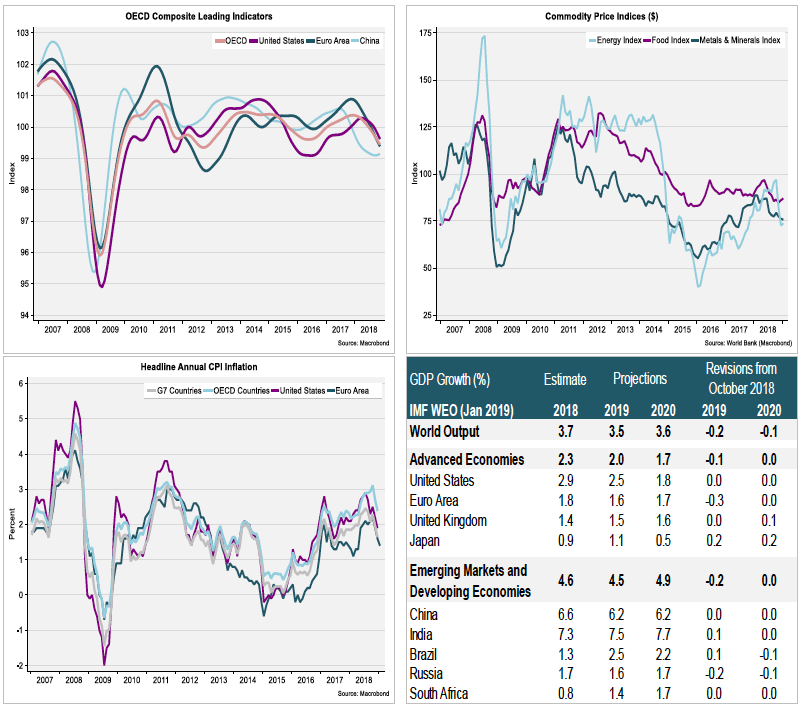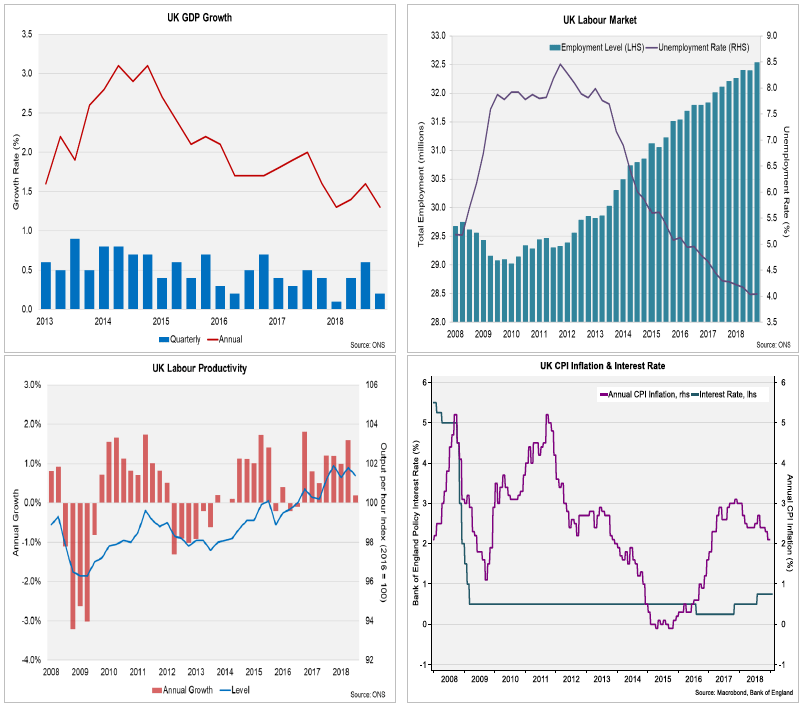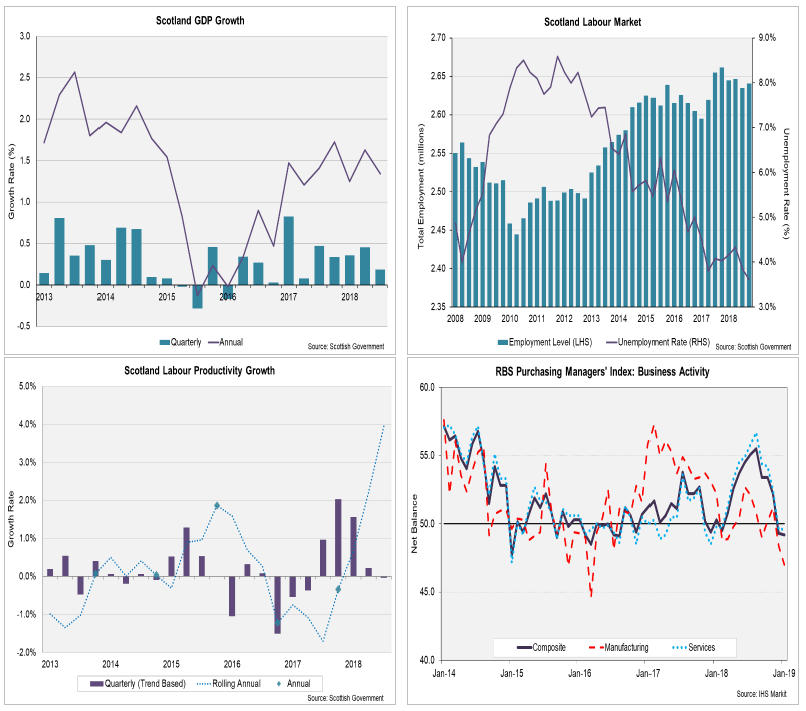State of the economy: February 2019
Report produced tri-annually by the Chief Economic Adviser to provide a picture of the Scottish economy in an international context, including Brexit impact analysis.
This document is part of a collection
Overview
Overall, 2018 has been a positive year for the Scottish economy, with growth returning across all sectors of the economy, the labour market delivering record levels of performance and further growth in exports.
Alongside this, the most recent data on business research and development trends and inward investment underline the attractiveness of Scotland.
All of this has been achieved against a backdrop of intensifying uncertainty regarding the UK’s exit from the EU, as well as, continuing structural challenges for particular firms and sectors of the economy.
Previous reports have touched on the potential channels through which Brexit has impacted the economy - in particular the impact of uncertainty and stockpiling on current economic activity.
This report picks up on no-deal risks and also publishes some additional analysis in terms of Scotland’s sectoral strengths in international trade and potential downside risks of a disorderly no-deal Brexit on key sectors of the economy.
As outlined previously, EU exit reflects a significant change to the terms of trade for the Scottish and UK economy. The extent to which this impacts sectors and regions of Scotland is dependent on both the shape of any final political agreement regarding market access (four freedoms) and over what time period any change comes into effect.
However, given the proximity to 29 March deadline, a no-deal Brexit remains a significant (and live) risk and would lead to a major dislocation to the Scottish economy. This would occur through a number of channels - disruptions to logistics, supply, trade, investment, migration and market confidence. Any shock is likely to have disproportionate sectoral, as well as, regional impacts and if prolonged, will lead to significant structural change in the economy.
The uncertainty relating to this is already impacting key economic indicators for Scotland. Business and consumer sentiment surveys report notable falls in confidence. The Scottish Consumer Sentiment Indicator has fallen to its lowest reading since the series began in 2013 while we know investment decisions by business have been skewed towards supply issues (distribution, warehousing and stocks) or put on hold.
Any consideration of the future outlook for the economy is caveated by EU exit, which even in the context of an orderly transition and a deal being agreed, has seen recent downward revisions to the UK economic outlook due to the uncertainty associated with this process.
Current independent forecasts for the Scottish economy remain positive for 2019 with growth between 1 and 1.5 per cent, but until EU exit is finalised these remain highly uncertain.
Global Summary
Global activity softened in the second half of 2018.
- Global growth has remained robust in 2018, however the pace of growth has softened in the second half of the year.
- Slower growth has been evident in both Advanced Economies, and Emerging Markets and Developing Economies, particularly in Europe and Asia.
- Growth in world trade volumes have continued to moderate compared to 2017 amid heightened trade tensions.
- Weaker commodity price growth has eased inflationary pressures and been more supportive of consumer spending.
- The IMF forecast global growth to slow over 2018 - 2019 (to 3.7% and 3.5%) before partially rebounding to 3.6% in 2020.
- Key risks to their global outlook include trade tensions, weaker investor sentiment and slower growth in China.
US GDP growth remained solid into the second half of 2018.
- US GDP growth slowed slightly in Q3 2018 to 0.8% however continued to strengthen over the year as a whole to 3%.
- US unemployment rose slightly to 4.0% in January – partly due to the partial federal government shutdown – however remains lower over the year.
- US CPI inflation fell at the end of 2018 to 1.9% - its first time below 2% since mid-2017 - driven by a fall in energy prices.
- The IMF forecast US GDP growth to accelerate to 2.9% in 2018 before easing back to 2.5% in 2019.
Euro Area growth slowed in the second half of 2018.
- Euro Area growth has weakened in the second half of 2018 and across the year as a whole, with growth falling to 0.2% in Q3 and Q4.
- The Euro Area unemployment rate remained stable at the end of 2018 at 7.9% in December, the lowest rate since October 2008.
- Euro Area inflation fell to 1.4% in January, down from 1.6% in December, driven mainly by weaker fuel price growth.
- The IMF forecast Euro Area GDP growth to slow to 1.8% in 2018 and 1.6% in 2019.

United Kingdom Summary
GDP growth slowed in Q4 2018.
- UK GDP grew 0.2% in the fourth quarter of 2018, slowing from 0.6% growth in the previous quarter.
- Service sector growth slowed in Q4 to 0.4%, driven by slower growth in Distribution, Hotels and Restaurants and Transport, Storage and Communication.
- The Production sector contracted in Q4 by 1.1%, with a broad based fall in output across the main sub sectors.
- Construction sector output fell 0.3% in Q4, driven in part by a 2.8% fall in output in December.
Labour market continues to perform strongly.
- Latest data in September to November 2018 show that the UK unemployment rate fell over the year to 4% - its joint lowest rate since 1974-75.
- The employment rate increased over the year to 75.8%, with 32.5 million people in employment.
- The inactivity rate continued to fall over the past year to 21%.
- GB nominal and real regular pay growth has strengthened in 2018 growing 3.3% and 1.1% over the year to November.
- Labour productivity contracted by 0.4% in Q3 2018, however grew 0.2% over the year as a whole.
CPI inflation continued to fall at the end of 2018.
- The CPI inflation rate fell in December to 2.1%, down from 2.3% in November.
- Downward contributions to the rate came from transport alongside footwear and clothing.
- The inflation rate continued its downward trend in the second half of 2018, falling from 3.0% in December 2017.
UK growth forecast to slow over the coming year.
- Growth is forecast to slow in 2019 with the Bank of England revising down their forecast to 1.2% (1.7% previously).
- While there is continued Brexit uncertainty, the forecasts assume a smooth transition

Scotland Summary
GDP growth softened in Q3 2018.
- Following a pick-up in growth in the first half of 2018, GDP growth in Scotland softened slightly to 0.2% in Q3 2018.
- There was further expansion in both the Services (0.2%) and Construction (2.9%) sectors, however this was partly offset by contraction in the Production sector (-0.9%).
- The Construction sector contributed most strongly to growth over the quarter followed by Business Services and Finance.
- GDP per person growth also slowed slightly over the quarter to 0.1% (0.9% annually).
Unemployment fell to record low in 2018.
- Over the year to September-November, the unemployment rate fell to 3.6% - its lowest rate on record.
- Alongside this, the number of people unemployed fell below 100,000 for the first time.
- The employment rate increased over the quarter and the past year to 75.3%, with 2.64 million people in employment.
- The inactivity rate also rose over the quarter and the year to 21.9% - partly off-setting the fall in unemployment.
Labour productivity growth picked up over the year.
- Labour productivity growth was flat (0.0%) in Q3 2018, however increased by 4.0% on a rolling annual basis (up from 2.2%).
- The increase in productivity over the year reflects that GVA grew 1.5% while total hours worked fell 2.4%.
Business and Consumer confidence weakened in 2018.
- Business activity softened at the end of 2018 and into January, while business confidence also weakened.
- In Q4 2018, consumer sentiment in Scotland fell to its lowest level on record, driven by weaker expectations for the outlook.
- Independent GDP growth forecasts reflect the stronger period of growth in 2017-18 estimating between 1.3% and 1.6%, slowing to between 1% and 1.5% in 2020.

Contact
Email: Office of the Chief Economic Adviser OCEABusiness@gov.scot
There is a problem
Thanks for your feedback